Role of cord blood and bone marrow mesenchymal stem cells in recent deep burn: a case-control prospective study
- PMID: 29142785
- PMCID: PMC5675835
Role of cord blood and bone marrow mesenchymal stem cells in recent deep burn: a case-control prospective study
Abstract
Rationale: Burn injuries represent one of the major worldwide public health problems causing more severe physiological stress than other traumas. Effective treatment of burn injuries is mandatory to prevent the numerous life-threatening complications and possible disabilities. Stem cells, a population of multipotent cells retaining the properties of self-renewal and differentiation, are the main player in tissue regeneration after major trauma. Thus, they are thought to play a key role in wound healing inducing efficient and physiological skin regeneration. Stem cell-based regeneration is quickly gaining scientific grounds.
Objective: This study was designed as a comparative prospective study to evaluate and compare the regenerative effect of bone marrow derived mesenchymal stem cells (BM-MSCs) and umbilical cord blood derived mesenchymal stem cells (UC-MSCs) compared to conventional early excision and graft (EE&G) in recent thermal full thickness burned patients.
Subject & methods: Recruited burned patients were randomly divided into three groups (20 patients on each group) having recent thermal full thickness percentage ranging from 10% to 25% total body surface area (TBSA). After receiving allocated treatment, they were assessed as regards: rate of burn healing, presence of post-burn complications both early (such as loss of graft and infections) and late (as hypertrophic scars, keloid, hypo- or hyperpigmentation or contracture of the wound), hospitalization time and cost.
Results: This study showed significantly improved rate of healing in both BM-MSC and UC-MSC groups as compared to EE&G group with no significant difference between bone marrow and umbilical cord groups. Comparing the incidence of early complications, partial and total loss of graft occurred in 50% patients in (EE&G) group, while infection complication appeared in 25% of patients of (BM-MSCs) group and in 70% of patients in (UC-MSCS) group. The late complications (hypertrophic scars) were observed in 40% of (EE&G) patients group, in 15% of (BM-MSCs) treated patients group and 20% of (UC-MSCS) patients group. Contractured scars were present in 15% in (EE&G) group, 10% in (BM-MSCs) group, 10% in (UC-MSCS) group. Hypopigmentation occurred in 20% of patients in (EE&G) group, 20% in (BM-MSCs) group and 10% in (UC-MSCS) group. Hyperpigmentation was present in 20% of patient in (EE&G) group, 30% in (UC-MSCS) group but no hyperpigmentation occurred in (BM-MSCs) group. There was no late complication in 5% of patient in (EE&G) group, 55% in (BM-MSCs) group and 30% in (UC-MSCS) group. The results of this study revealed that the hospitalization period was significantly reduced in both (BM-MSCs) group and (UC-MSCS) group as compared to (EE&G) group.
Conclusion: this study proves that mesenchymal stem cells, both from bone marrow and cord blood origin, can effectively improve healing of burn injuries.
Keywords: Stem cells; burn; contractured scars; graft loss; hypopigmentation.
Conflict of interest statement
None.
Figures
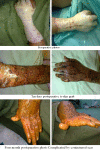

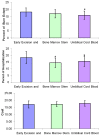
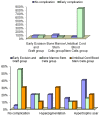
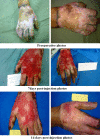
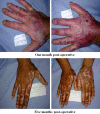

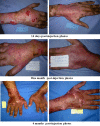

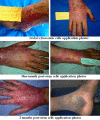
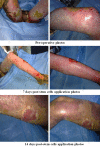
Similar articles
-
The effect of mesenchymal stem cells improves the healing of burn wounds: a phase 1 dose-escalation clinical trial.Scars Burn Heal. 2022 Jun 28;8:20595131211070783. doi: 10.1177/20595131211070783. eCollection 2022 Jan-Dec. Scars Burn Heal. 2022. PMID: 35781931 Free PMC article.
-
Comparison of therapeutic effects of mesenchymal stem cells from umbilical cord and bone marrow in the treatment of type 1 diabetes.Stem Cell Res Ther. 2022 Aug 8;13(1):406. doi: 10.1186/s13287-022-02974-1. Stem Cell Res Ther. 2022. PMID: 35941696 Free PMC article.
-
Effect of Allogeneic Bone Marrow-mesenchymal Stem Cells (BM-MSCs) to Accelerate Burn Healing of Rat on the Expression of Collagen Type I and Integrin α2β1.Pak J Biol Sci. 2016;19(8-9):345-351. doi: 10.3923/pjbs.2016.345.351. Pak J Biol Sci. 2016. PMID: 29023021
-
Umbilical Cord Mesenchymal Stem/Stromal Cells Potential to Treat Organ Disorders; An Emerging Strategy.Curr Stem Cell Res Ther. 2022;17(2):126-146. doi: 10.2174/1574888X16666210907164046. Curr Stem Cell Res Ther. 2022. PMID: 34493190 Review.
-
Stem cell-based therapy for human diseases.Signal Transduct Target Ther. 2022 Aug 6;7(1):272. doi: 10.1038/s41392-022-01134-4. Signal Transduct Target Ther. 2022. PMID: 35933430 Free PMC article. Review.
Cited by
-
Current Advanced Therapies Based on Human Mesenchymal Stem Cells for Skin Diseases.Front Cell Dev Biol. 2021 Mar 9;9:643125. doi: 10.3389/fcell.2021.643125. eCollection 2021. Front Cell Dev Biol. 2021. PMID: 33768095 Free PMC article. Review.
-
Orchestration of Mesenchymal Stem/Stromal Cells and Inflammation During Wound Healing.Stem Cells Transl Med. 2023 Sep 15;12(9):576-587. doi: 10.1093/stcltm/szad043. Stem Cells Transl Med. 2023. PMID: 37487541 Free PMC article. Review.
-
Exploring the therapeutic potential of different sources of mesenchymal stem cells: a novel approach to combat burn wound infections.Front Microbiol. 2024 Nov 29;15:1495011. doi: 10.3389/fmicb.2024.1495011. eCollection 2024. Front Microbiol. 2024. PMID: 39678916 Free PMC article. Review.
-
Mesenchymal Stem Cells in Burn Wound Management.Int J Mol Sci. 2022 Dec 5;23(23):15339. doi: 10.3390/ijms232315339. Int J Mol Sci. 2022. PMID: 36499664 Free PMC article. Review.
-
The skin regeneration potential of a pro-angiogenic secretome from human skin-derived multipotent stromal cells.J Tissue Eng. 2019 Mar 12;10:2041731419833391. doi: 10.1177/2041731419833391. eCollection 2019 Jan-Dec. J Tissue Eng. 2019. PMID: 30886688 Free PMC article.
References
-
- Barret D, Rassef N, Franck Skin injury. Burn. 2002;vol. 1 ch. 3: pp. 29-42.
-
- Hyun I. Magic eggs and the frontier of stem cell center. Hastings Cent Rep. 2006;36:16–19. - PubMed
-
- Lu W, Zhang YJ, Jin Y. Potential of stem cells for skin regeneration following burns. Expert Rev Dermatol. 2009;4:97–99.
-
- Kastrinaki MC, Sidiropoulos P, Roche S, Ringe J, Lehmann S, Kritikos H, Vlahava VM, Delorme B, Eliopoulos GD, Jorgensen C, Charbord P, Häupl T, Boumpas DT, Papadaki HA. Functional, molecular and proteomic characterisation of bone marrow mesenchymal stem cells in rheumatoid arthritis. Ann Rheum Dis. 2008;67:741–9. - PubMed
-
- Al-Nbaheen M, Vishnubalaji R, Ali D, Bouslimi A, Al-Jassir F, Megges M, Prigione A, Adjaye J, Kassem M, Aldahmash A. Human stromal (mesenchymal) stem cells from bone marrow adipose tissue and skin exhibit differences in molecular phenotype and differentiation potential. Stem Cell Rev. 2003;9:32–43. - PMC - PubMed
LinkOut - more resources
Full Text Sources
Other Literature Sources
